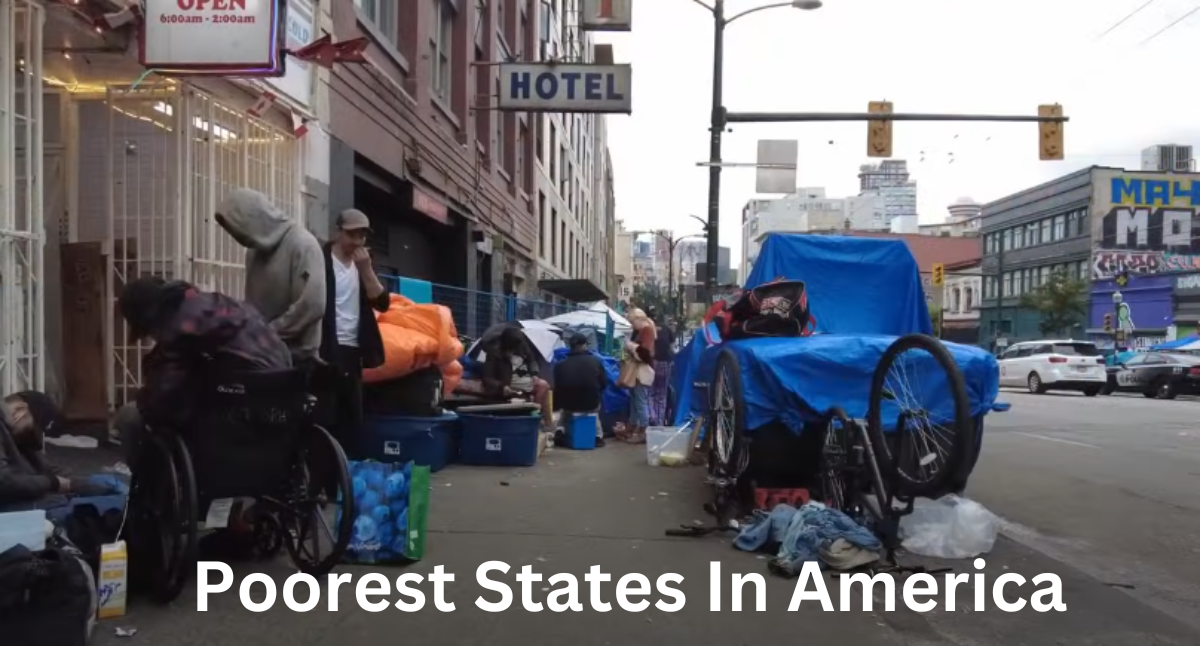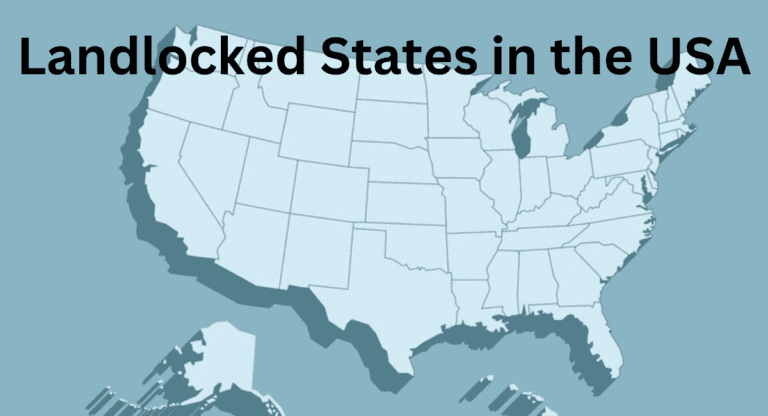Top 12 Poorest States In America in 2024
The United States, a land of opportunity and prosperity, has a surprising reality: millions of its citizens struggle financially. Despite ranking high among the world’s wealthiest nations, over 11.5% of the population lives in poverty. This translates to roughly 37.9 million people facing challenges like low income, unemployment, and limited access to education.
This issue isn’t new. The fight against poverty has roots that go back to the Great Depression, with programs designed to offer support. The recent COVID-19 pandemic further strained the situation, pushing an additional eight million into poverty.
So, which states feel the pinch the hardest? This article explores the realities of the poorest states in America. We’ll discover the reasons behind these low incomes and how they affect the lives of everyday people.
A List of the 12 Poorest US States
Below is a list of the 12 poorest US states:
- Mississippi
- West Virginia
- Arkansas
- Louisiana
- New Mexico
- Alabama
- Kentucky
- Oklahoma
- South Carolina
- Tennessee
- North Carolina
- Georgia
1. Mississippi
Located in the Southeastern United States, Mississippi has a median income of $52,985, making it the state with the lowest income nationwide. The state faces significant economic challenges, with 19.1% of its population living below the poverty line. Mississippi is also one of the states with the highest levels of food insecurity, affecting 20% of its residents. This means one in five people in the state lacks access to sufficient quality food.
Agriculture is the predominant industry in Mississippi, with 35% of the state’s land dedicated to farmland. Other important industries include manufacturing and fishing. However, this limited economic diversification makes the state particularly vulnerable to natural disasters such as hurricanes, floods, and fires. Additionally, inadequate education contributes to ongoing economic difficulties.
On a positive note, the state’s educational outcomes have improved. The percentage of students earning their high school diplomas is at an all-time high, with the high school dropout rate decreasing by 8.5% between 2022 and 2023. Currently, 89.4% of students in Mississippi complete high school.
Explore More: 10 Most Rich States in the USA
2. West Virginia
West Virginia, situated in the Appalachian region of the United States, has a median income of $55,217 and a poverty rate of 17.9%. The state’s largest employer is the government, which accounts for approximately one-fifth of all jobs. However, West Virginia’s heavy reliance on the energy and mining industries has revealed significant vulnerabilities, especially in light of declining energy prices and the downturn of the coal industry. The transition to renewable energy has been challenging, as many residents perceive it as a threat to the traditional coal sector.
Another major issue facing West Virginia is its aging infrastructure. Much of the state’s infrastructure, including roads, bridges, and drinking water systems, was constructed over 70 years ago and is now in need of repair and modernization. The state’s declining population exacerbates these challenges, leading to reduced tax revenue and, consequently, fewer resources for necessary infrastructure updates. This population decline hampers the state’s ability to advance and maintain essential services.
Addressing these intertwined challenges requires a multifaceted approach. West Virginia must prioritize economic diversification, investing in renewable energy initiatives and workforce training programs to mitigate the impacts of declining coal production. Simultaneously, targeted infrastructure investments, bolstered by federal support, can revitalize the state’s aging systems and stimulate economic growth.
3. Arkansas
Arkansas, located in the south-central United States, has a household median income of $56,335, ranking it as the third lowest in the nation. The state contends with significant economic challenges, evidenced by the fact that 16.8% of its population lives below the poverty line. Agriculture is the cornerstone of Arkansas’s economy, generating $16 billion in revenue annually. The state’s vast forested areas, which cover 56% of its land, also make forestry a vital industry. However, despite the economic contributions of these sectors, the jobs they provide often come with low wages, which contributes to the overall low median income.
Limited access to quality education and healthcare further compounds Arkansas’s economic difficulties. These deficiencies hinder the development of a skilled workforce and worsen socioeconomic disparities.
The state’s economic landscape reveals a pressing need for diversified industries and improved social services to uplift its population and reduce poverty rates. Addressing these challenges will be crucial for Arkansas to enhance its economic resilience and improve the quality of life for its residents.
4. Louisiana
Louisiana, located in the southern United States, has a median household income of $57,852, with 18.6% of residents living below the poverty line. This issue is particularly severe in rural areas, where 59% of residents struggle to meet basic needs. Louisiana ranks fourth in the nation for wealth inequality, reflecting one of the most unequal distributions of wealth in the country.
The state’s economy is heavily reliant on the chemical and energy sectors, with manufacturing accounting for approximately one-sixth of the state’s GDP. These industries have made Louisiana vulnerable to economic instability due to global market fluctuations. Furthermore, the state’s inadequate public education system has contributed to the persistence of poverty and low wages.
Improving educational outcomes and diversifying the economy are critical steps toward mitigating these economic challenges. Investment in infrastructure and social services, alongside efforts to attract new industries, will be essential for fostering sustainable economic growth and enhancing the quality of life for Louisiana’s residents.
Explore More: Most Dangerous Prisons in the United States
5. New Mexico
New Mexico, located in the southwestern United States, has a median household income of $58,722, with 17.6% of residents living below the poverty line. The situation is particularly dire for Native Americans in the state, with 31% living in poverty, significantly higher than the state average. The economy heavily relies on the public sector, with about one in five workers employed in government positions.
The state’s education system is a major factor contributing to economic instability and poverty. Approximately 77% of students graduate from high school, and only 70.9% of adults have proficient literacy levels. This low graduation rate and lack of literacy skills confine many individuals to low-wage jobs, limiting their career opportunities and exacerbating issues such as homelessness and hunger.
Addressing these educational deficiencies is crucial for improving economic conditions and providing better opportunities for New Mexico’s residents.
6. Alabama
Alabama, located in the heart of the US South, has a median household income of $59,609, with 16.2% of its population living below the poverty line. Much of the state’s current inequality stems from its agricultural history, which is deeply intertwined with slavery, racial discrimination, and segregation. Historically reliant on cotton plantations, Alabama was a significant participant in the enslavement of Africans, with nearly half of its population enslaved during the 19th century. Although slavery was abolished in 1865, its legacy continues to impact the present, particularly affecting African American communities, who experience poverty at disproportionately high rates.
Efforts to address these enduring issues are ongoing, with activists advocating for more inclusive education and legislative changes. These initiatives aim to rectify historical injustices and create a more equitable society, ultimately improving economic conditions and opportunities for all residents of Alabama.
Enhancing access to quality education, healthcare, and employment opportunities is critical in breaking the cycle of poverty and fostering long-term economic growth in the state. Moreover, investment in infrastructure and community development programs can help uplift disadvantaged communities and pave the way for a more prosperous future for Alabama.
Also Read: The Best Places to Live in Alabama
7. Kentucky
The east-south-central state of Kentucky ranks seventh among the poorest states, with a median household income of $60,183. Similar to West Virginia, Kentucky relies heavily on the manufacturing and coal mining industries, which have faced significant challenges in recent years due to the gradual shift toward renewable energy.
Additionally, climate change has inflamed the situation, leading to longer droughts and more frequent floods. These environmental changes have reduced crop yields for key agricultural products such as tobacco and corn, deeply impacting Kentucky’s economy, as agriculture remains a leading industry.
Moreover, Kentucky’s educational system struggles with low literacy levels, inadequate funding, and poor student performance, frequently ranking near the bottom among states. These educational deficiencies have long-term repercussions on household income levels, perpetuating the cycle of poverty. Addressing these issues through investment in education, diversification of the economy, and infrastructure improvements is essential for enhancing the state’s economic resilience and quality of life for its residents.
8. Oklahoma
Located in the southwest region of the United States, Oklahoma has a median household income of $61,364. However, poverty has persisted in the state since its inception, attributed to historic droughts, limited resources, and inadequate infrastructure. Currently, 15.7% of the population lives below the poverty line. Economic instability and poverty are exacerbated by high unemployment rates and limited job opportunities, particularly impacting communities of color and residents of Eastern Oklahoma.
Furthermore, nearly one in three employees earn a median wage that places them below the poverty line. The state’s education system also faces challenges, as Oklahoma ranks among the lowest in education spending per pupil, leading to neglected educational infrastructure.
Addressing these issues requires strategic investments in education, infrastructure, and economic diversification to uplift communities and improve opportunities for all Oklahomans. By prioritizing these investments, Oklahoma can work towards reducing poverty, fostering economic growth, and enhancing the overall well-being of its residents.
9. South Carolina
Situated in the coastal southeastern region of the United States, South Carolina showcases a median household income of $63,623, with a poverty rate of 14%. Despite this, many residents struggle due to low wages, limited affordable housing options, heightened vulnerability to natural disasters, and disparities in the K-12 education system. The quality of public education varies significantly across neighborhoods and geographical areas, perpetuating a cycle of poverty for those born into lower-income communities.
Moreover, South Carolina faces challenges in providing affordable rental housing for low-income households, leading some families to allocate more than half of their incomes toward housing costs alone. This financial strain often necessitates cuts in other essential expenses such as healthcare and nutritious food, further exacerbating economic hardships.
Addressing these systemic issues requires concerted efforts to enhance education equity, expand affordable housing options, and promote economic opportunities for all South Carolinians. Additionally, investments in community development programs and infrastructure improvements can help create a more equitable and prosperous future for the state’s residents.
10. Tennessee
Tennessee, with a median household income of $64,035, is among the states with the lowest incomes. Its poverty rate is 13.3%, exceeding the national average of 11.5%. Poverty is particularly prevalent in rural areas and varies significantly by county. For example, Moore County reports a child poverty rate of only 3%, while Hancock County faces a staggering 45% rate.
These geographic disparities extend to educational outcomes, with children in economically disadvantaged counties being only half as likely to achieve proficiency in reading compared to their counterparts in wealthier areas. This lack of equitable access to quality education perpetuates the cycle of low wages and poverty in these regions. Addressing these disparities requires targeted efforts to enhance educational opportunities, promote economic development, and reduce poverty across all Tennessee counties.
Moreover, Tennessee’s reliance on industries such as agriculture and manufacturing, which often offer low-wage employment, contributes to its persistent poverty challenges. Additionally, limited access to healthcare and affordable housing further increases economic hardships for many residents. Comprehensive strategies that address these multifaceted issues are essential for fostering sustainable economic growth and improving the well-being of all Tennesseans.
11. North Carolina
North Carolina confronts significant economic hurdles as it grapples with being one of the poorest states in America. As of 2021, the poverty rate hovered around 13.98%. The state’s economic landscape has been shaped by the decline of traditional industries like textiles and furniture manufacturing, posing challenges for many residents.
One pivotal factor exacerbating North Carolina’s economic disparities is the wage gap. Despite its robust economy, the state’s median household income falls below the national average, with minority communities experiencing heightened disparities. Efforts to address income inequality, along with enhancing access to affordable healthcare and education, have gained momentum in recent years.
To revitalize the economy, North Carolina is actively investing in sectors such as renewable energy, technology, and healthcare. However, the journey to uplift the state’s economy and alleviate poverty is complex and ongoing, demanding sustained collaboration between the public and private sectors to implement comprehensive solutions. Despite these challenges, North Carolina remains resilient, with concerted efforts aimed at fostering inclusive growth and prosperity for all its residents.
12. Georgia
Georgia grapples with a persistent poverty rate of 14.28%, impacting approximately 1.4 million residents despite ongoing efforts to stimulate economic growth and expand employment opportunities. Income inequality stands out as a significant contributor to Georgia’s economic challenges, with a notable disparity between top earners and those at the bottom of the income scale. Moreover, rural areas in the state often experience higher poverty rates compared to urban centers, underscoring the uneven distribution of economic opportunities.
To combat poverty, Georgia has implemented initiatives focused on job creation, education, and social welfare programs. However, addressing poverty comprehensively remains a multifaceted challenge, requiring tailored solutions suited to the state’s unique economic landscape.
Continued commitment to alleviating poverty and promoting inclusive economic growth is essential for enhancing the overall well-being of Georgians statewide. This necessitates ongoing attention and collaborative efforts from government, businesses, and community stakeholders.
Also Read: Most Dangerous Cities in the US
A Table Comparison of the Poorest States in the United States of America
| US State | Population | Median Household Income | Poverty Rate |
| Mississippi | 2,883,074 | $52,985 | 19.58% |
| West Virginia | 1,755,591 | $55,217 | 17.10% |
| Arkansas | 2,923,585 | $56,335 | 16.08% |
| New Mexico | 2,053,909 | $58,722 | 18.55% |
| Louisiana | 4,532,187 | $57,852 | 18.65% |
| Kentucky | 4,322,881 | $60,183 | 16.61% |
| Alabama | 4,771,614 | $59,609 | 15.98% |
| Oklahoma | 3,833,712 | $61,364 | 15.27% |
| South Carolina | 4,950,181 | $63,623 | 14.68% |
| Tennessee | 6,603,468 | $64,035 | 14.62% |
| North Carolina | 10,098,330 | $60,516 | 13.98% |
| Georgia | 10,238,369 | $67,730 | 14.28% |
Final Words
In conclusion, the poorest states in America grapple with formidable challenges, including income inequality and limited job opportunities. Addressing these issues necessitates comprehensive efforts focused on investment in education, healthcare, and economic development.
Collaboration among government entities, the private sector, and local communities is paramount for implementing effective solutions and creating opportunities for all residents. By prioritizing inclusive growth and implementing targeted policies, these states can work towards alleviating poverty and enhancing the overall well-being of their populations. Through this article, we have highlighted the top 12 poorest states in America, shedding light on the urgency of addressing poverty and fostering equitable prosperity across the nation.
FAQs
How Do the Economies of Canada and California Compare In Terms of Size?
Canada’s GDP stands at approximately 2 trillion USD, while California’s GSP (gross state product) was around 3.6 trillion USD as of 2022. This indicates that California’s economy, confined within its state boundaries, surpasses Canada’s overall economic output by a significant margin.
Which U.S. State Holds the Title of the Wealthiest?
According to a U.S. News & World Report ranking released in November, New Jersey claims the top spot. The ranking utilized data from the U.S. Census Bureau’s American Community Survey estimates from 2022 to determine states with the highest median household income.
Who Was the First Millionaire in California and a Notable Figure in American History?
Samuel S. Brannan holds this distinction. He established California’s first newspaper in San Francisco and also served as a settler, businessman, and journalist.
Which Is the World’s Wealthiest State?
Maharashtra claims this title, boasting a Gross State Domestic Product (GSDP) exceeding ₹31 trillion. Maharashtra, housing Mumbai, the financial capital of India, stands at the forefront of economic prosperity. Mumbai, the largest city in the country, serves as a hub for major banks, multinational corporations, and the stock exchange, solidifying Maharashtra’s status as the wealthiest state.

I’m Sophia Jones, an adventurer at heart from New York City, USA. I live for travel and exploration, always eager to discover new places, meet fascinating people, and try out diverse cuisines. Over the past few years, I’ve traveled to numerous countries, immersing myself in different cultures and creating unforgettable memories.






